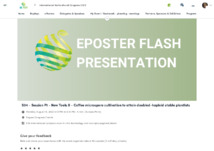Coffee microspore cultivation to attain doubled-haploid stable plantlets.
Coffee microspore cultivation to attain doubled-haploid stable plantlets.
Autoria: ANGELO, P. C. da S.; PEREIRA, L. F. P.; SERA, G. H.; SETA, T.
Resumo: The aim of this study was to explore the potentials of progenies produced by the introgression of disease resistance from related Coffea species to C. arabica . In the IDR-Parana, Brazil, hybrids of C. arabica (tetraploid) x C. racemosa (diploid) were obtained. Self-pollination of some of these hybrids produced very mild yields, despite the backcros to C. arabica . In an attempt to regenerate stable double-haploids, anthers and isolated microspores were grown in vitro . It was assumed that chromosomes captured in a microspore after meiosis can acquire homo and/or homeologous stability faster in vitro than in vivo. C. arabica anthers served as control. Flowers were collected when the young microspores were uninucleated, and disinfected with 8% active chlorine. Microspores were extracted in 90 mM mannitol using a food mixer that worked for a few seconds, washed and centrifuged twice at 100xg and grown in modified N6 liquid medium (10 5 cells/mL in 35 mm diameter plates). Explants were grown continuously for six months on the same N6 medium containing 6.5 mg/L auxins, 1.0 mg/L cytokinins and 0.5 mg/L gibberellin (GA3), at 27 o C in the dark. Isolated microspores produced embryo-like structures or microcalli at very low frequencies (0.3 per plate). The anthers, on the other hand, produced embryogenic calli . One particular endogenous fungus infected 70% of the control anthers but 5% produced friable calli . Some of these were embryogenic, but arrested when compared to calli produced by the interspecific hybrid anthers. Regarding the hybrid anthers, 25% were infected by a same endogenous bacteria but 8% produced embryogenic tissue, with globular embryos multiplying and maturing simultaneously upon transfer to N6 medium without growth regulators. After 1.2 years, the photomorphogenesis has been induced under light, and auxin/cytokinin ratio = 2 plus GA3.
Ano de publicação: 2022
Tipo de publicação: Resumo em anais e proceedings
Unidade: Embrapa Café
Palavras-chave: Café, Embriogénese, Embryogenesis, Pollen, Pólen, Rubiaceae
Observações
1 - Por padrão são exibidas publicações dos últimos 20 anos. Para encontrar publicações mais antigas, configure o filtro ano de publicação, colocando o ano a partir do qual você deseja encontrar publicações. O filtro está na coluna da esquerda na busca acima.
2 - Para ler algumas publicações da Embrapa (apenas as que estão em formato ePub), é necessário ter, no celular ou computador, um desses softwares gratuitos. Sistemas Android: Google Play Livros; IOS: iBooks; Windows e Linux: software Calibre.
Acesse outras publicações
Acesse a Base de Dados da Pesquisa Agropecuária (BDPA) para consultar o acervo completo das bibliotecas da Embrapa.

